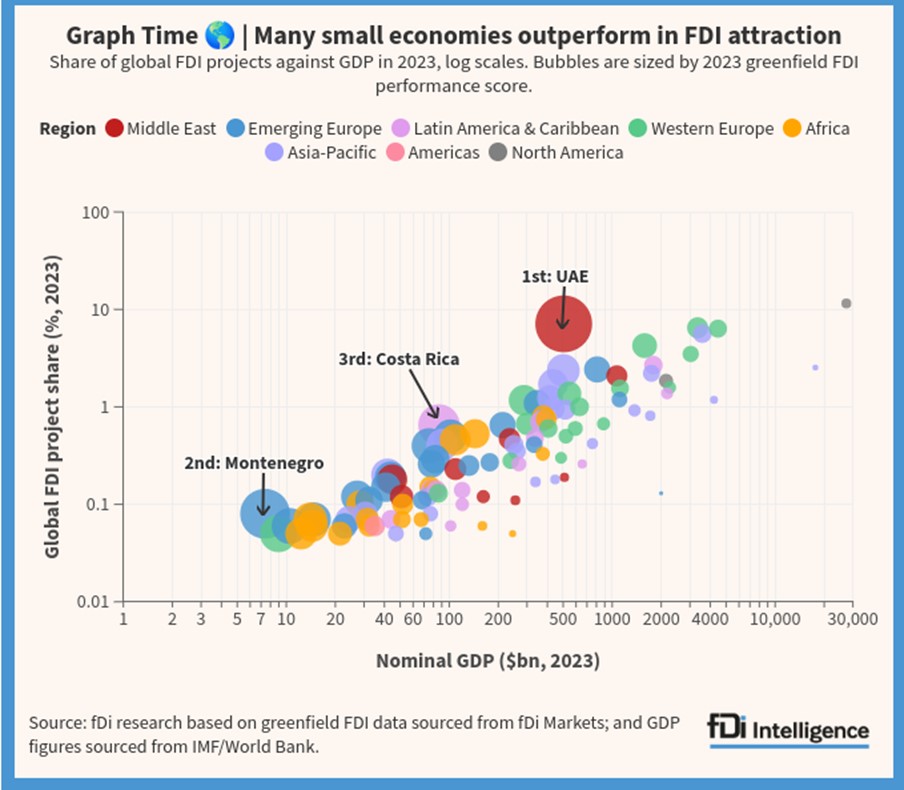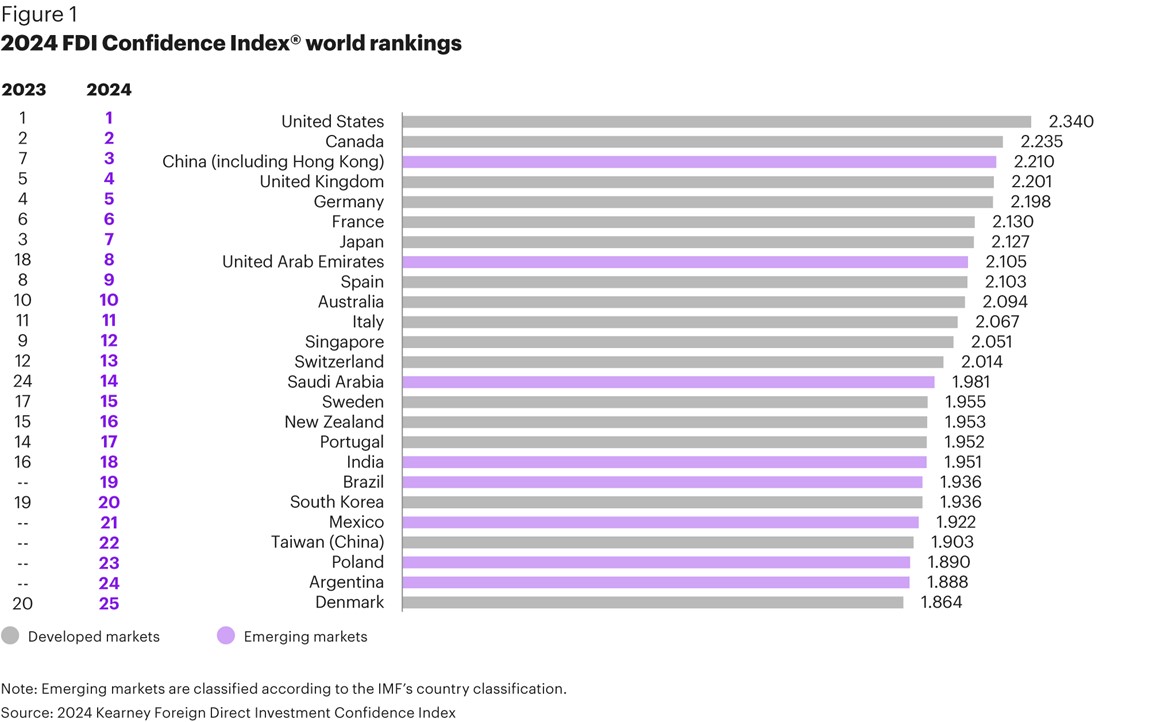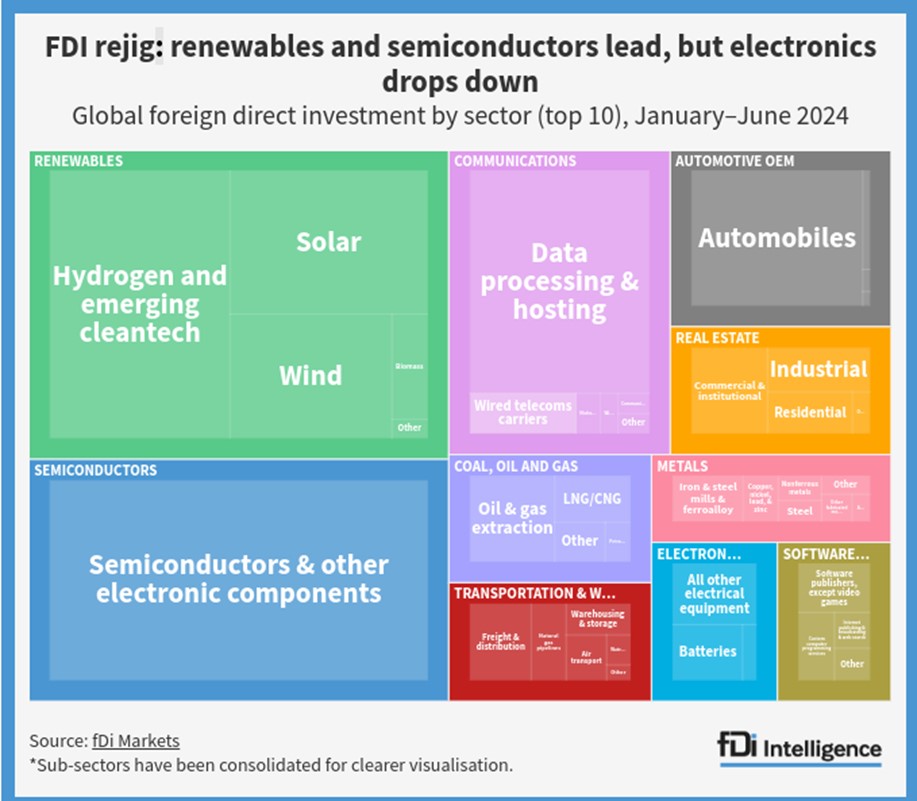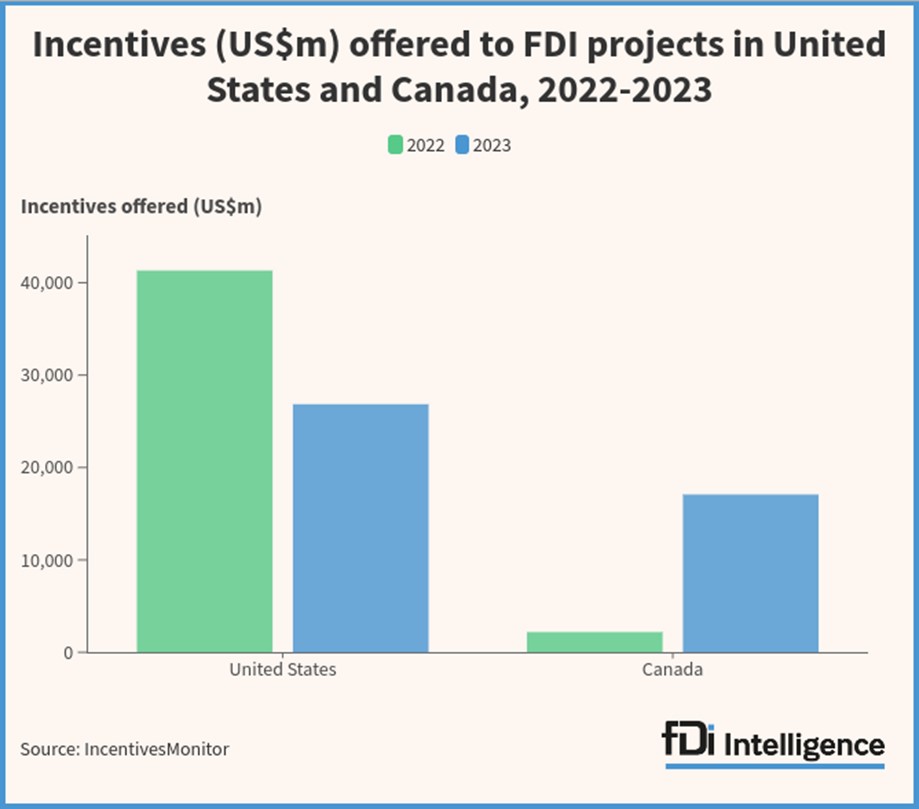- Navigator
- Prospecting and Business Attraction
 With its promised benefits in terms of job creation, greater competitiveness, and economic growth, foreign direct investment (FDI) is one of the most crucial forces driving the economic development of communities worldwide.
With its promised benefits in terms of job creation, greater competitiveness, and economic growth, foreign direct investment (FDI) is one of the most crucial forces driving the economic development of communities worldwide.
The United States remains the leader and prime destination for FDI despite changes in global trends in 2024 resulting from emerging technologies and geopolitical dynamics.
In this article, I’ll dissect these trends and offer insights and practical advice for economic development organizations (EDOs) and professionals across the US and beyond who want to help their communities navigate the twists and turns of attracting FDI for growth and development.
Changes to US Manufacturing FDI Market
The decline in US manufacturing foreign direct investment (FDI) reached its lowest point in over a decade in 2023, reflecting both global economic challenges and shifts in corporate investment strategies. According to data from FDI Intelligence, the value of manufacturing-related FDI in the US has dropped to levels not seen since the aftermath of the 2008 financial crisis.
This decline has significant implications for economic development professionals, as manufacturing has traditionally been a cornerstone for job creation, supply chain strength, and technological innovation in many regions across the country.
Several factors contribute to this downward trend, including global economic uncertainty, supply chain disruptions, and the increasing emphasis on reshoring and nearshoring strategies.
Faced with rising costs in areas like labor and raw materials, companies are reevaluating where and how they allocate their investments. In particular, the geopolitical environment and trade tensions have shifted investment away from traditional manufacturing hubs, pushing companies to explore alternative locations that offer more favorable conditions.
While the overall volume of investment has decreased, regions that can offer a competitive advantage — whether through skilled labor, advanced infrastructure, or incentive packages — still stand to attract significant portions of the remaining investment. EDOs must focus on enhancing their value propositions to appeal to companies that are rethinking their global footprint.
The Dominance of the United States in FDI Attraction
The majority of FDI is still going to developed markets, with the US at the top of the heap for over a decade. Despite the low point reached in the manufacturing sector, the total number of investment projects in the US remained stable in 2023.
The robust growth of the US economy has outstripped many other developed nations during this time, and strong consumer confidence underscores our attractiveness to global investors.
This dominance did not happen by chance. It comes from an investment climate that results in economic conditions suitable for innovation, sophisticated infrastructure, and highly skilled labor.
When marketing to potential investors, EDOs should highlight these strengths locally, focusing on the areas of highest growth potential and stability, and focusing on sectors that offer the strongest competitive advantage.
Emerging FDI Markets and Related Strategies
Saudi Arabia and the United Arab Emirates (UAE) have also seen increased FDI in recent years. This increase represents a broader economic shift and has opened new markets in these countries, including in strategic sectors like technology and infrastructure.
The UAE climbed two positions from last year’s ranking, reflecting that it was the country with the largest increase (+316) in FDI projects in 2023 from a year earlier, according to fDi Markets. This growth in project numbers was most notable in the business services, tech, real estate, and industrial equipment sectors.
This trend warrants a two-fold strategy for American economic development professionals:
- Understand the competitive threats that these emerging markets pose.
- Seek opportunities that open doors for cross-border partnerships that can actually reinforce the domestic value chain, particularly in innovation-driven industries.
Investor Optimism and Its Impact on Economic Development Strategies
According to the Kearney FDI Confidence Index, corporate executives are still optimistic, with a majority (88%) stating they will increase their FDI in the coming years.
That is music to the ears of those of us working in business attraction and economic development and demands a proactive response from EDOs. Leveraging this optimism will require:
- Engaging investors to understand their long-term objectives
- Incentivizing those objectives
- Having a stable and innovative economic environment

The Double-Edged Sword of Geopolitical Tensions and Regulatory Environments
According to the Kearney FDI Confidence Index, geopolitical tensions and regulatory complexities are significant concerns for investors, impacting FDI flows and influencing corporate site selection decisions.
On a more positive note for the United States, such tensions also drive nearshoring and “friendshoring”. This means EDOs must pay close attention to global news and be ready to proactively adjust business attraction strategies when opportunities arise by emphasizing regional stability, clear and consistent regulatory guidelines, and economic resilience.
Industry Breakdowns for 1st Half of 2024
Practical Strategies EDOs Can Use to Attract FDI
Global investors’ priorities are constantly evolving, so EDOs must employ a diverse range of creative strategies that highlight their communities’ strengths and benefits and align with those priorities.
Using Technology and Data Analytics Strategically
Digital transformation has changed the way EDOs work, presenting previously unheard-of opportunities for them to track and attract potential investors. Technologies such as artificial intelligence (AI), GIS platforms, and data analytics tools can help analyze global investment trends, identify target sectors, and conduct outreach. EDOs should leverage technology strategies such as:
- AI-driven market research, which can help identify emerging industry trends and potential prospect attributes, enabling more effective targeting of investment attraction prospects.
- Data analytics to observe global economic indicators, market activity, and competitive intelligence, improving strategic decision-making.
- Digital technology and platforms to generate potential prospects, such as identifying and targeting website visitors and converting them into attraction prospects.
Encouraging Sustainable Energy Investments and Green Projects
With the world focusing on sustainability and renewable energy, environmentally friendly projects have become excellent targets for FDI.
EDOs should position themselves to attract such investments, especially if those targets align with organization-wide strategic targets. To effectively attract this type of investment, EDOs should consider strategies such as:
- Promoting local renewable energy projects, which emphasizes the community’s commitment to eco-friendly projects.
- Developing incentive programs for green projects, such as tax breaks, grants, or expedited permitting processes.
- Targeting investors interested in sustainability through marketing that emphasizes the region’s commitment to sustainability.
According to the report published by OCO Global, the Inflation Reduction Act (IRA) is another reason why these types of projects have become so important in attracting FDI to the US from countries around the world.
A major impact that policies like the IRA have had on the market is that companies now view incentives as one of the primary motivations for deciding where they should expand or relocate their operations. The fact that the IRA is able to help provide incentives for extremely large projects increases the likelihood that the United States will be able to land those types of green projects.
The data backs this up as well as FDI Intelligence’s 2024 Global Incentives Report has shown that incentives for FDI-backed projects reached an all-time high in 2023, at $60.3 billion, with the United States leading the charge with a total of $26.8 billion handed out to companies to incentivize FDI into the US in 2023 and a whopping $33.4 billion already handed out in 2024. Alternative/Renewable energy was one of the leading industries that received incentives during this time frame, behind other major sectors including Automotive, Semiconductors, and Electronic Components.
There has been a drop off in Electric Vehicles (EV) investment and sales in the EV market, which has resulted in some changes to strategies from large automotive companies in terms of ramping up production on EV vehicles. However, hybrid sales have continued to rise, showing that the market is still strong, but is likely to grow at a slower pace than originally anticipated.
Developing Strategic International Alliances
International partnerships are mandatory in promoting a region to foreign investors in the global economy. In this respect, EDOs should consider:
- Developing connections with foreign EDO counterparts to encourage cross-border investment, exchanging best practices, and working together on mutually beneficial marketing efforts.
- Partnering with global firms looking to expand their portfolios, offering them access to local markets.
- Taking part in marketing missions, international trade shows, and other investment forums to network with foreign companies, learn about their requirements, and further promote their community’s value proposition.
- Building relationships virtually with international-based executives using tools such as LinkedIn Sales Navigator.
Improving Collaboration with Local Stakeholders
Attraction strategies for FDI must include mutual efforts from the local, regional, and state governments, educational institutions, private industry, and the community. EDOs can improve their efforts to attract FDI by:
- Strengthening relationships with local businesses, universities, and government institutions will make it easier for new companies and talent to establish themselves in the community. Connecting with international companies with local offices can create networking opportunities and new prospects if they can provide testimonials and promote your region to their home countries.
- Encouraging public-private partnerships to develop infrastructure, technology parks, and innovation hubs to create attractive features for foreign investors.
- Bringing academic institutions to the table to help make the region a hot spot for high-tech and knowledge-based industries, which will encourage research collaboration and talent development.
Leveraging Nearshoring, Reshoring, and Friendshoring
Nearshoring, reshoring, and friendshoring are very trendy terms right now. They offer major opportunities for EDOs to attract FDI right away but may require communities to reposition themselves to be receptive to companies looking to realign their global operations. EDOs can take advantage of these trends by:
- Stressing geographic and strategic advantages: EDOs must emphasize the region’s proximity to significant markets, publicize relevant infrastructure, and promote its stable political environment.
- Focusing on shared values and alignments: Friendshoring emphasizes the importance of shared values and alignments. EDOs can market their region’s similarity to international standards, trade agreements, and political coalitions, appealing to companies prioritizing operational stability and like-minded regulatory environments.
- Tailoring incentives for reshoring activities: Craft incentive packages that cater to the needs of companies considering reshoring can be a decisive factor. Tax breaks, research and development grants, or workforce training support are some potential incentives.
When EDOs proactively and creatively use these targeted strategies, they will positively impact their community’s FDI attraction success and contribute to its overall prosperity.
Camoin Associates stays at the forefront of understanding these strategies and the FDI global landscape to help our clients with their attraction efforts.
To learn more about how Camoin Associates’ lead generation and FDI attraction services can help your organization, contact Dillion Roberts, our Director of ProspectEngage®, or visit our website.
📍 Related Article:




